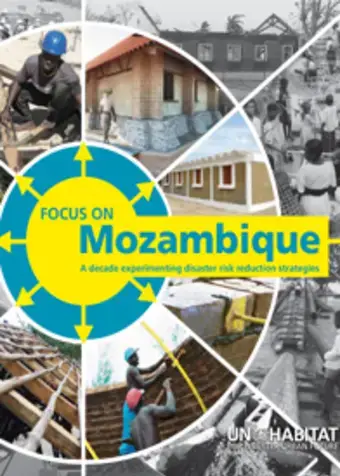 This profile prepared by UN-Habitat provides a spotlight into 9 neighbourhoods of the Old City and 3 adjacent neighbourhoods. It builds on the Homs City Profile prepared in May 2014. The objective of this Profile is to provide a snapshot of the situation, emergency issues and future implications that the UN and humanitarian community can take into account.
This profile prepared by UN-Habitat provides a spotlight into 9 neighbourhoods of the Old City and 3 adjacent neighbourhoods. It builds on the Homs City Profile prepared in May 2014. The objective of this Profile is to provide a snapshot of the situation, emergency issues and future implications that the UN and humanitarian community can take into account.
City Profile Homs. Multi Sector Assessment
 Homs is the third largest city in Syria, after Aleppo and Damascus. The precrisis population of Homs was approximately 800,000. The city was well known for its integration of multi-cultural communities, as it received a big proportion of migrants from all the surrounding rural areas before the crisis.
Homs is the third largest city in Syria, after Aleppo and Damascus. The precrisis population of Homs was approximately 800,000. The city was well known for its integration of multi-cultural communities, as it received a big proportion of migrants from all the surrounding rural areas before the crisis.
City Profile Lattakia. Multi Sector Assessment
 Lattakia is a major Syrian city situated on the Mediterranean Sea, Lattakia is an important port playing an essential role in the imports and exports for Aleppo (Syria's industrial capital) and for the Syrian Eastern Region. In 2010, the Syrian Central Bureau of Statistics (CBS) estimated the population of Lattakia City at approximately 425,500 inhabitants.
Lattakia is a major Syrian city situated on the Mediterranean Sea, Lattakia is an important port playing an essential role in the imports and exports for Aleppo (Syria's industrial capital) and for the Syrian Eastern Region. In 2010, the Syrian Central Bureau of Statistics (CBS) estimated the population of Lattakia City at approximately 425,500 inhabitants.
City Profile Dara'a. Multi Sector Assessment
 Dara'a is the central city of the Syrian southern region, located next to the borderline with Jordan. The precrisis population of Dara'a was approximately 117,000, and thus did not have a dominant population in the Governorate of Dara'a that had a population of 1,042,500 distributed in major secondary cities north and north west of Dara'a city.
Dara'a is the central city of the Syrian southern region, located next to the borderline with Jordan. The precrisis population of Dara'a was approximately 117,000, and thus did not have a dominant population in the Governorate of Dara'a that had a population of 1,042,500 distributed in major secondary cities north and north west of Dara'a city.
City Profile Aleppo. Multi Sector Assessment
 The crisis in Syria has had a significant effect on the country’s major cities, with large scale movements of population, damage to buildings and infrastructure and interruptions to markets. Cities represent multiple and inter-related formal and informal systems and need to be described and analysed in an integrated manner that captures the complexity of urban conditions.
The crisis in Syria has had a significant effect on the country’s major cities, with large scale movements of population, damage to buildings and infrastructure and interruptions to markets. Cities represent multiple and inter-related formal and informal systems and need to be described and analysed in an integrated manner that captures the complexity of urban conditions.
Southern Africa to benefit from Risk Reduction Centre
 Lilongwe, 18 December 2014 – A new regional centre for southern Africa will help develop resilience action plans, vulnerability mapping and disaster risk reduction as well as climate change adaptation planning.
Lilongwe, 18 December 2014 – A new regional centre for southern Africa will help develop resilience action plans, vulnerability mapping and disaster risk reduction as well as climate change adaptation planning.
UN-Habitat commemorates International Day for Disaster Reduction with Government and Partners in Myanmar
 Nay Pyi Daw, 16 October 2014 – The International Day for Disaster Reduction was commemorated at the National and Regional levels in Myanmar on 13 October 2014 by the Government of Myanmar, UN Agencies, International and National Non-Governmental Organizations, Civil Society, Elderly Persons and Students.
Nay Pyi Daw, 16 October 2014 – The International Day for Disaster Reduction was commemorated at the National and Regional levels in Myanmar on 13 October 2014 by the Government of Myanmar, UN Agencies, International and National Non-Governmental Organizations, Civil Society, Elderly Persons and Students.
UN-Habitat partners with Australia to combat disaster risk for four Sri Lankan cities
 Colombo, 15 September 2014: UN-Habitat, in partnership with the Municipal Council of Akkaraipattu, Urban Councils of Vavuniya and Mannar and the Pradeshiya Sabha of Maritimepattu (Mullaitivu), officially launched the Disaster Risk Reduction and Preparedness Plan for each City at the Water’s Edge in Battaramulla on Monday. These Plans have been developed with funding from the Government of Australia.
Colombo, 15 September 2014: UN-Habitat, in partnership with the Municipal Council of Akkaraipattu, Urban Councils of Vavuniya and Mannar and the Pradeshiya Sabha of Maritimepattu (Mullaitivu), officially launched the Disaster Risk Reduction and Preparedness Plan for each City at the Water’s Edge in Battaramulla on Monday. These Plans have been developed with funding from the Government of Australia.

